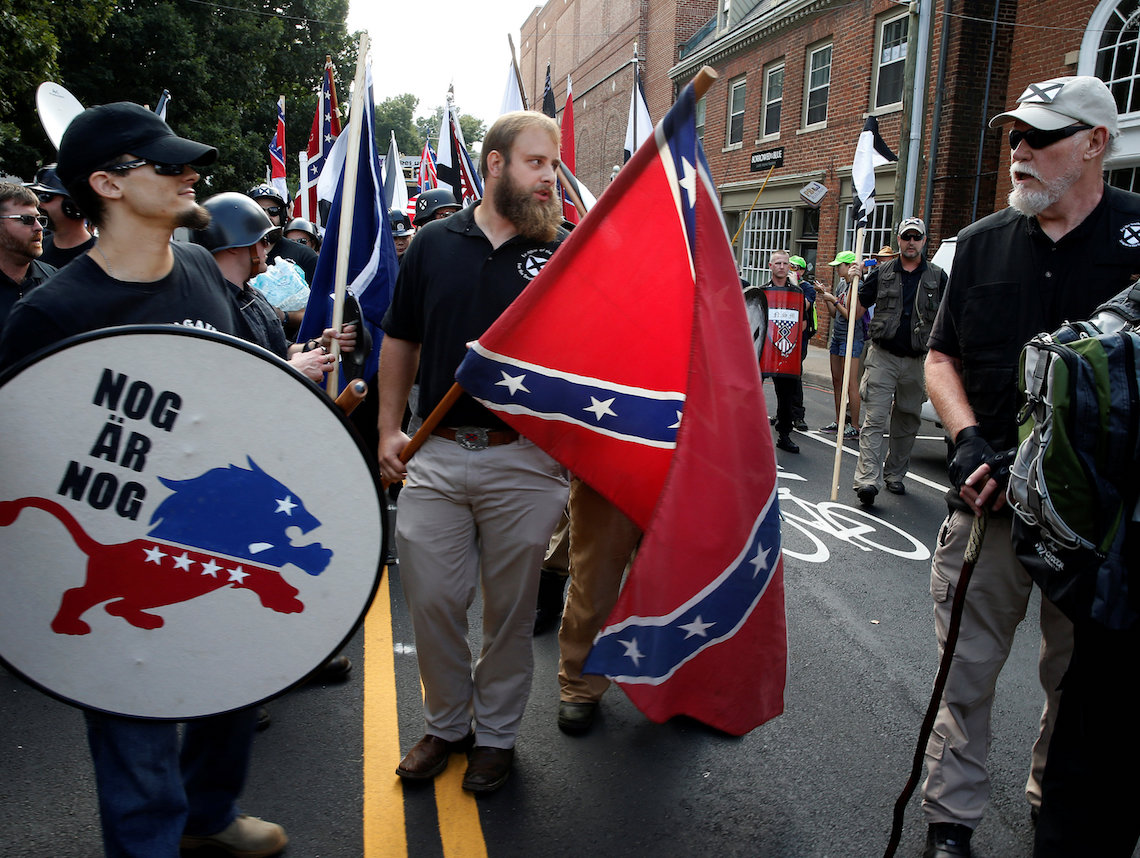 White supremacists carry a shield and Confederate flag as they arrive at a rally in Charlottesville, Va., on August 12. Photo by Joshua Roberts/Reuters
White supremacists carry a shield and Confederate flag as they arrive at a rally in Charlottesville, Va., on August 12. Photo by Joshua Roberts/Reuters The smartest graffito I ever saw proclaimed “If I didn’t believe it with my own mind, I never would have seen it.” The converse works too: deep beliefs blind people to the obvious.
Maybe that observation explains president Donald Trump’s insistence that last weekend’s Charlottesville debacle was really about a Robert E. Lee statue, despite the ubiquitous Nazi flags, and the chants of “Jews will not replace us.”
Trump is not entirely wrong that there was violence on both sides. Many Nazis were eager for a fight, and some of the anti-fascists (who have disrupted conservative speakers on campuses in recent months) were too. But for him to equate the groups with the presidential stamp of moral equivalence does more to promote white supremacy than any other presidential act in memory.
The Nazi-like torch-lit march to the Lee statue, and the Nazi flags (let alone the Confederate ones) should have been enough to tell the president that this event wasn’t about anything other than white supremacists feeling empowered to express their belief that the only true Americans are white Americans.
Trump said he needed a couple of days to figure out what happened, but didn’t he hear the “Jews will not replace us” chant? Does he have any clue what that means?
White supremacists see themselves as biologically superior to non-whites. Yet they see America becoming a nation that will, in just a few decades, be majority non-white. They fear they are being “replaced,” but how can they be losing this battle to people they define as inferior? The explanation is that there is a hand on the scale, making them lose. It’s the Jews, and their support for immigration and civil rights for all, that are the culprits.
Jews are “replacing” whites in two ways, in their view. One is the perceived power of the Jewish community, which while small has had great success in many spheres. They also believe Jews actively seek to destroy whites by injecting “inferior races” into society. This is not a new libel. The charge that Jews secretly conspire to harm non-Jews is at the core of Nazism. It was also popular among many of the “America Firsters” of the 1930s.
The chants about Jews, the flags, the torches, were clear evidence – in their own words and actions – what the alt-right was organizing for. So how was Trump so blind and deaf?
Perhaps because he knows that to many of his supporters the slogan “Make America Great Again” means “Make America White Again.”
Perhaps because he gained the presidency by stoking fears of the “other,” the other being non-white immigrants and Muslims, while retweeting antisemitic memes.
White supremacists not only revel in Trump’s stereotyping of people they loath, they easily see the Trump double standard.
Yes, there are immigrants who commit acts of violence, and Trump holds immigrants responsible as a group. Yes there are Muslims who commit acts of terror, and Trump effectively blames all Muslims.
When white supremacists and neo-Nazis spew hatred, he says wait, there are some good people among them, you can’t tar a whole group; and as a matter of fact those who oppose the white supremacists are no better.
The double standard goes further. Imagine a Muslim man plowing a car into demonstrators. Within nanoseconds the presidential Twitter finger would have blamed “radical Islamic terrorists.” Same act by a white supremacist – where’s the tweet?
The Nazis have good reason to feel empowered. They see a president targeting non-white groups, and twisting logic like a pretzel to defend white racists. They know that others whom they seek to recruit, who might otherwise fear being associated with overt hate, see the president essentially saying it’s ok.
Symbols are powerful, and people have died for them. The rallying point for the alt-right was not Robert E. Lee as a person, but Robert E. Lee as a symbol of white supremacy. But again, Trump missed the obvious. He’s not entirely wrong that some on the left would want to remove symbols of slavery, and that by that logic Washington and Jefferson are troubling figures. I agree with him that these statues (unlike the Confederate flags over statehouses) should stay. We erase the troubling parts of our history at our peril; much better to leave them – Lee included – and surround them with explanations why they were venerated as part of an effort – that still continues – to promote the oppression of black Americans.
But Trump made no such distinction, and his statements over the last days have ensured there will be other Charlottesvilles, the white supremacists believing the president is behind them.
When this happens, policing must be better (keeping groups apart), and other political figures – as many did this past week — must condemn white supremacy in strong terms.
Local groups, including religious and human rights groups, have a key role here too.
Earlier this year, faced with a threatened, armed, neo-Nazi march in western Montana, the Justus & Karin Rosenberg Foundation partnered with the Montana Human Rights Network to launch a “project lemonade” response. People made financial pledges, so if the Nazis marched, they would donate money (up to a specified limit) tied to how long the march lasted. The money would go to things the Nazis detested, such as security for Jewish institutions, hate crime training for the police, and educational efforts against bigotry. In effect, the Nazis’ speech wasn’t free – they were helping raise money for things to defeat them and their message.
The Nazis didn’t show up in Montana, after people from around the country made Lemonade pledges.
I encourage other local groups to adopt this same strategy. It’s a way for all of us to stand together against hate, even when the president does not.
Kenneth S. Stern is the Executive Director of the Justus & Karin Rosenberg Foundation.























 More news and opinions than at a Shabbat dinner, right in your inbox.
More news and opinions than at a Shabbat dinner, right in your inbox.